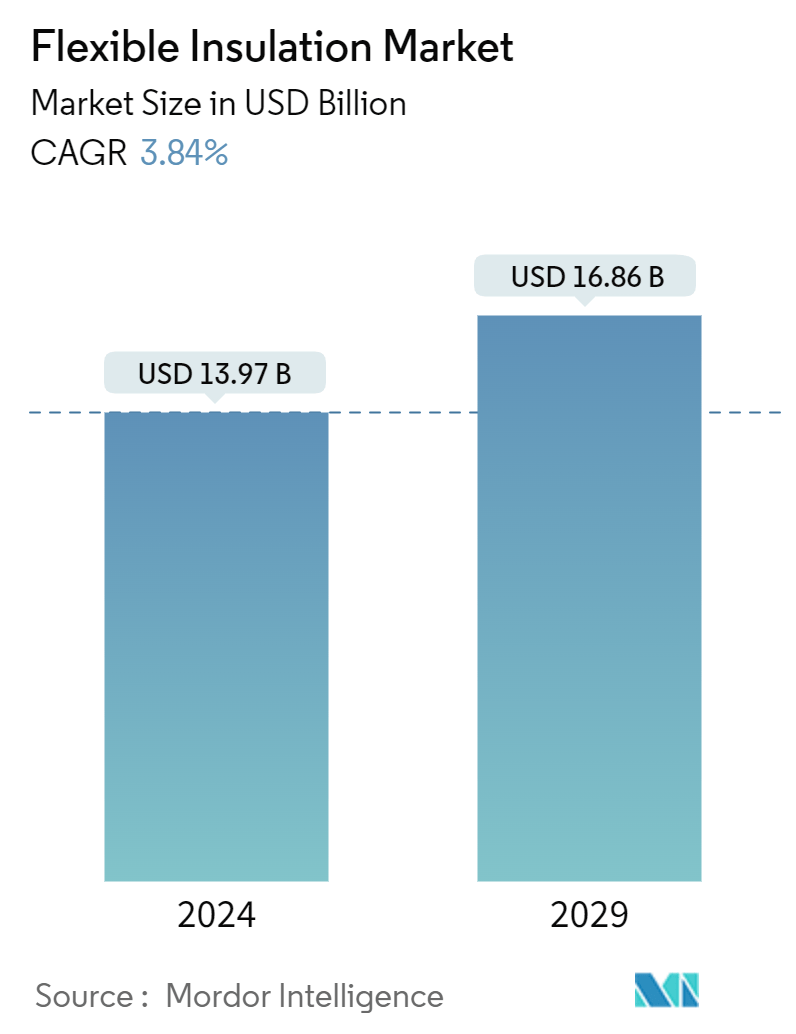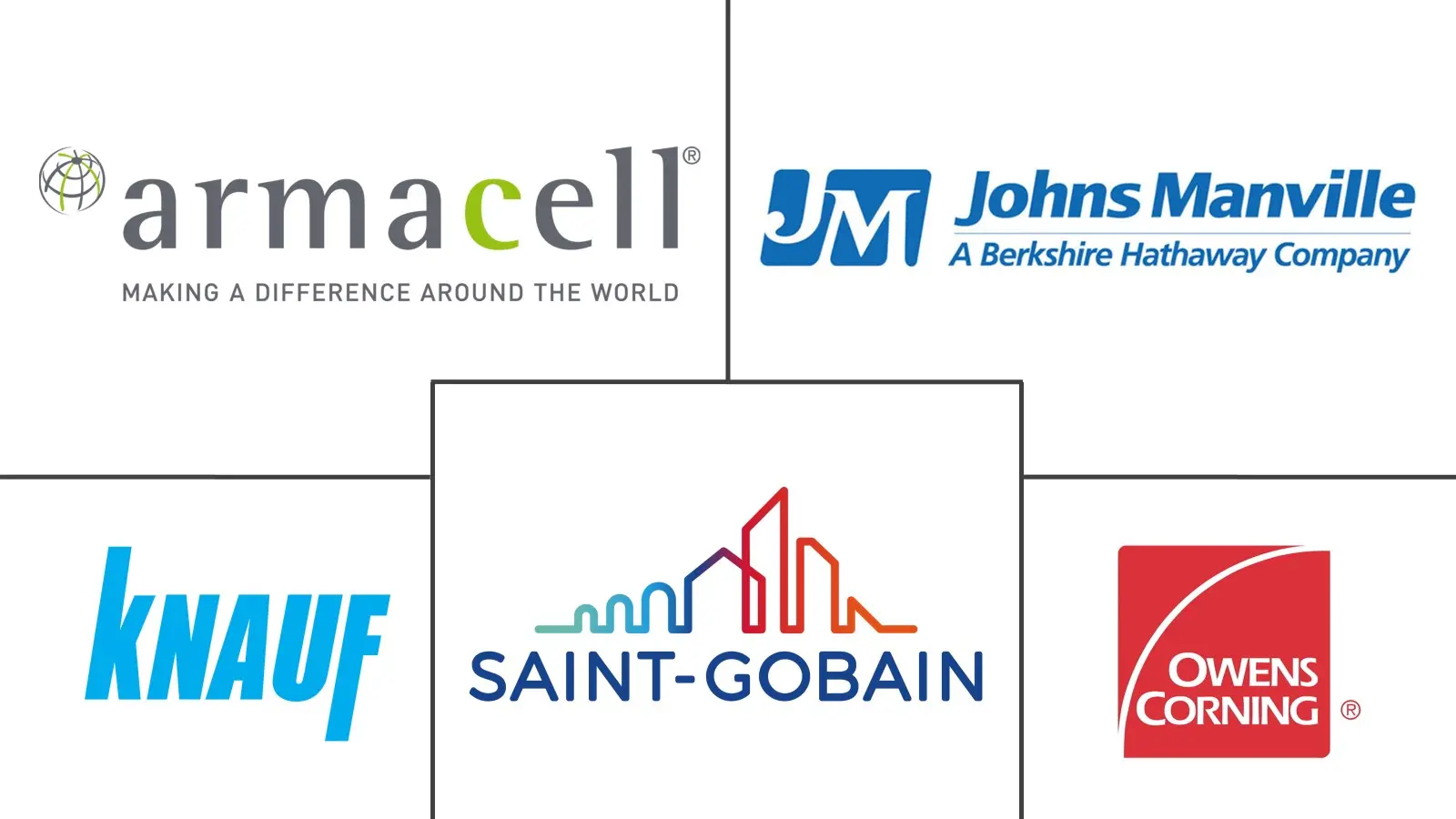Market Size of Flexible Insulation Industry

| Study Period | 2019 - 2029 |
| Market Size (2024) | USD 13.97 Billion |
| Market Size (2029) | USD 16.86 Billion |
| CAGR (2024 - 2029) | 3.84 % |
| Fastest Growing Market | Asia Pacific |
| Largest Market | Europe |
| Market Concentration | Medium |
Major Players
*Disclaimer: Major Players sorted in no particular order |
Flexible Insulation Market Analysis
The Flexible Insulation Market size is estimated at USD 13.97 billion in 2024, and is expected to reach USD 16.86 billion by 2029, growing at a CAGR of 3.84% during the forecast period (2024-2029).
- The increasing demand for energy efficiency from the construction industry and the increasing application of flexible piping insulation are expected to drive the flexible insulation market in the coming years.
- However, the availability of better alternatives is expected to hinder the growth of the market.
- Emerging opportunities for aerogel insulation in electric vehicles are expected to create opportunities for the market during the forecast period.
- Europe is expected to dominate the market, while Asia-Pacific is expected to register the highest CAGR owing to the increasing consumption from countries such as China, India, and Japan.
Flexible Insulation Industry Segmentation
Flexible insulation is a type of insulation composed of materials such as fiberglass, aerogel, XLPE, and elastomers that offer insulation against noise, high temperatures, etc.
The flexible insulation market is segmented by material, insulation type, and geography. By material, the market is segmented into aerogel, cross-linked polyethylene, elastomer, fiberglass, and others. By insulation type, the market is segmented into acoustic insulation, electrical insulation, and thermal insulation. The report also covers the market size and forecasts for flexible insulation in 15 countries across major regions. For each segment, the market sizing and forecasts are done on the basis of revenue (USD).
| By Material | |
| Aerogel | |
| Cross-Linked Polyethylene | |
| Elastomer | |
| Fiberglass | |
| Other Materials |
| By Insulation Type | |
| Acoustic Insulation | |
| Electrical Insulation | |
| Thermal Insulation |
| By Geography | |||||||
| |||||||
| |||||||
| |||||||
| |||||||
|
Flexible Insulation Market Size Summary
The flexible insulation market is poised for growth, driven by increasing demand for energy efficiency in the construction industry and the expanding application of flexible piping insulation. Despite the presence of superior alternatives that may impede market expansion, emerging opportunities such as aerogel insulation in electric vehicles are expected to provide new avenues for growth. Europe is anticipated to lead the market, supported by stringent building energy codes and robust construction activities, particularly in Germany and the United Kingdom. Meanwhile, the Asia-Pacific region is projected to experience the highest growth rate, fueled by rising consumption in countries like China, India, and Japan.
Fiberglass insulation, a key component in the flexible insulation market, is gaining traction due to its excellent thermal and acoustic properties, eco-friendly manufacturing process, and versatility in application forms. The material's non-combustible and non-corrosive nature, along with its resistance to mold and chemicals, makes it suitable for various industrial and construction applications. The increasing use of recycled materials in fiberglass production is also contributing to its growing demand. The market is characterized by fragmentation, with major players such as Armacell, Knauf Group, Johns Manville, Owens Corning, and Saint-Gobain playing significant roles in shaping its landscape.
Flexible Insulation Market Size - Table of Contents
-
1. MARKET DYNAMICS
-
1.1 Market Drivers
-
1.1.1 Increasing Demand for Energy Efficiency from the Construction Industry
-
1.1.2 Increasing Application of Flexible Piping Insulation
-
1.1.3 Other Drivers
-
-
1.2 Market Restraints
-
1.2.1 Availability of Alternatives
-
1.2.2 Other Restraints
-
-
1.3 Industry Value Chain Analysis
-
1.4 Porter's Five Forces Analysis
-
1.4.1 Bargaining Power of Suppliers
-
1.4.2 Bargaining Power of Buyers
-
1.4.3 Threat of New Entrants
-
1.4.4 Threat of Substitute Products and Services
-
1.4.5 Degree of Competition
-
-
-
2. MARKET SEGMENTATION (Market Size in Value)
-
2.1 By Material
-
2.1.1 Aerogel
-
2.1.2 Cross-Linked Polyethylene
-
2.1.3 Elastomer
-
2.1.4 Fiberglass
-
2.1.5 Other Materials
-
-
2.2 By Insulation Type
-
2.2.1 Acoustic Insulation
-
2.2.2 Electrical Insulation
-
2.2.3 Thermal Insulation
-
-
2.3 By Geography
-
2.3.1 Asia - Pacific
-
2.3.1.1 China
-
2.3.1.2 India
-
2.3.1.3 Japan
-
2.3.1.4 South Korea
-
2.3.1.5 Rest of Asia-Pacific
-
-
2.3.2 North America
-
2.3.2.1 United States
-
2.3.2.2 Canada
-
2.3.2.3 Mexico
-
-
2.3.3 Europe
-
2.3.3.1 Germany
-
2.3.3.2 United Kingdom
-
2.3.3.3 France
-
2.3.3.4 Italy
-
2.3.3.5 Rest of Europe
-
-
2.3.4 South America
-
2.3.4.1 Brazil
-
2.3.4.2 Argentina
-
2.3.4.3 Rest of South America
-
-
2.3.5 Middle East and Africa
-
2.3.5.1 Saudi Arabia
-
2.3.5.2 South Africa
-
2.3.5.3 Rest of Middle East and Africa
-
-
-
Flexible Insulation Market Size FAQs
How big is the Flexible Insulation Market?
The Flexible Insulation Market size is expected to reach USD 13.97 billion in 2024 and grow at a CAGR of 3.84% to reach USD 16.86 billion by 2029.
What is the current Flexible Insulation Market size?
In 2024, the Flexible Insulation Market size is expected to reach USD 13.97 billion.

